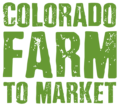The USDA currently funds three food assistance programs to assist low-income individuals and families in making purchases at farmers’ markets. The programs are the Supplemental Nutrition Assistance Program (SNAP), formerly the Food Stamp Program; the Senior Farmers’ Market Nutrition Program (SFMNP); and the WIC Farmers’ Market Nutrition Program (FMNP).
SNAP is run by Colorado Department of Human Services’ Food Assistance Program. The SFMNP is run by the Colorado Department of Human Services’ State Unit on Aging, and Colorado does not currently participate in the FMNP program.
Farmers’ markets can benefit from selling to low-income individuals and families by accepting EBT cards. SNAP participants can benefit from local access to healthful food products and plants at farmers’ markets.
(SNAP) provides low-income consumers access to nutritious foods, through the allotment of electronic benefits, for food purchases at authorized venues. SNAP participants receive an Electronic Benefit Transfer (EBT) card, usable like a debit card, for access to SNAP benefits. SNAP benefits can be used for purchasing food for the household to eat, including: grain products, fruit, vegetables, meats, poultry, fish, and dairy products. SNAP benefits can also be used to purchase seeds and plants to produce food for the household. Besides non-food items or products not for human consumption, SNAP benefits cannot be used for any alcohol products, vitamins or supplements, hot foods at point-of-sale, or foods to be eaten in the store.
Preliminary data as of March 2020 reports national SNAP participation is serving 37,347,458 people in March 2020. (source) Colorado reported 439,355 participants in March 2020, which was a 3 percent increase from the previous year (source).
To accept EBT at farmers’ markets or individual vendors, a point-of-sale (POS) terminal needs to be accessible. This could either be an EBT-only machine that can be obtained for free by USDA’s Food and Nutrition Service (FNS), or a commercial POS machine that will also accept debit and credit cards in addition to EBT. Limiting factors for use of either POS machine is the need for additional time and resources to implement the program. In addition, the EBT-only machine requires electricity and a phone line connection. Interested farmers’ markets need to obtain a license through FNS as a SNAP retailer. Individual vendors at FNS licensed farmers’ markets do not need to obtain separate licenses. For more information on how farmers’ markets can accept EBT, or to apply for a FNS license, visit www.fns.usda.gov/snap/ebt/fm.htm.
The Colorado Department of Human Services (CDHS) has received FNS funding to provide no-cost wireless EBT machines to farmers markets and direct-marketing farmers for two years, through September 2021.
It is recommended that farmers’ markets provide training for vendors in SNAP participation, to clarify vendor reimbursement methods and specific guidelines for SNAP benefits use which include:
-
SNAP must only be used on eligible food items.
-
No change or cash back can be given for SNAP purchases.
-
SNAP purchases are tax exempt.
Farmers’ markets can choose to set up SNAP purchasing by either making scrip or tokens available to participants, or implementing a vendor receipt system. For specific information and examples to successfully provide SNAP participants access at a farmers’ market, please review the USDA publication, “SNAP at Farmers’ Markets: A How-To Handbook”
COVID-19 Information
As concerns about the spread of COVID-19 grows, farmers market managers have been modifying operations for optimal safety and mitigating exposure.
Farmers’ Market managers should consult their local health authorities for best safety practices while opening and operating. The CDC has issued a guide of considerations for large public gatherings.
Highlights include:
-
Establishing relationships with local health departments for broader planning efforts and steps needed in case of cancelation or postponement.
-
Proper disinfection, ventilation and social distancing measures.
-
Using signs and messages from credible health organizations to promote daily practice of preventative actions such as hand washing and wearing face coverings.
-
Providing prevention supplies such as sinks with soap, hand sanitizer, gloves, masks and tissues.
For additional information on farmers’ market food assistance programs available in certain areas of the U.S., visit the following fact sheets :
Updated July 2020
